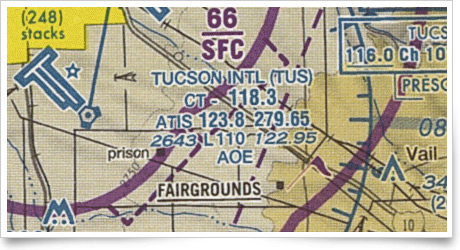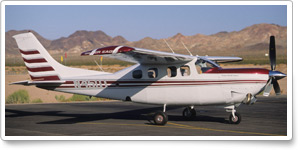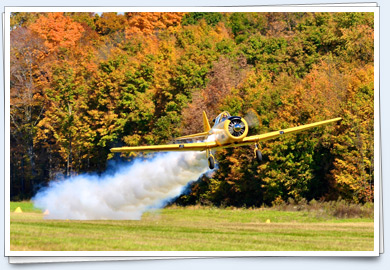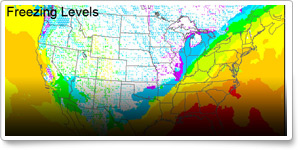|
| ||||||
| ||||||
| Commercial airport destinations |
| |||||
| Sponsored by: | ||||||
Training TipsCommercial airport destinations
Whether your home airport is lively or laid back, eventually your flying may cross trails with larger, faster, or unfamiliar aircraft. Learning how to blend in seamlessly is a fun challenge of flight training.
Checking a busy destination’s published listing is always a good start. Another useful step is to contact the FBO where you will park or refuel and ask some questions—especially if you plan to change locations on the airport or go into town. AOPA “strongly recommends that pilots flying to an airport that offers any type of airline service check the hours of operation, call the FBO for transient pilot security procedures, and plan ahead if an escort is needed after-hours,” says this AOPA regulatory brief.
Coming and going, expect to hear callouts about a variety of traffic. You might be instructed to follow that traffic as part of your landing clearance. That will put your textbook knowledge of wake turbulence avoidance into practice for real. Don’t forget to consider effects of surface winds on wake movement. Will the reported wind dissipate wingtip vortices, or move them into your path?
Your ability to recognize the types of aircraft flying nearby—by sight and as identified in radio calls—will help you manage wake-turbulence risk. Stay especially alert for the word “heavy” after an aircraft call sign.
Making an accurate landing and exiting promptly at the next available taxiway will earn you ATC’s gratitude—but aircraft control remains your top priority. Don’t resort to excessive braking and risk possible loss of control.
Progressive taxi instructions are a gift at a busy, unfamiliar airport. Explain that you are a student pilot if you become confused or uneasy.
Looking over this sectional chart excerpt for Tucson International Airport’s Class C airspace, you see the unfamiliar letters AOE below the airport information. What does that mean? The abbreviation tells you that Tucson is an airport of entry to the United States.
Flight Training NewsTecnam, Mechtronix to develop P2006T simulatorTecnam is teaming up with Mechtronix Systems to develop a simulator for Tecnam’s P2006T twin-engine aircraft. The project includes a simulator and a conversion kit for existing simulators. The new training platform will be marketed as the P2006T Ascent Flight Trainer and will feature Garmin G1000 avionics and instrumentation needed to conduct instrument training. Cessna announces safety initiative for older airframesCessna Aircraft Co. has begun a safety initiative aimed at educating the owners of 100- and 200-series single-engine piston aircraft about new, supplemental aircraft inspection procedures that will be added to Cessna service manuals. The inspections cover single-engine piston aircraft produced between 1946 and 1986. Inspections will be incorporated into the service manuals for the 200-series aircraft in December. The change for the 100-series aircraft will be made in April 2012. View a video on the supplemental inspections online.
Hamburger hop at nightOnce you have your certificate, a night flight with friends to your favorite airport restaurant can be a breathtaking experience for everyone. Your passengers will love the city lights unfolding below them and the thrill of taxiing up to the restaurant on the field. But are your skills and credentials up to the flight? Take the Air Safety Institute's quiz, sponsored by the AOPA Insurance Agency, to find out about night currency requirements and weather considerations before you venture into the night sky. Take the quiz >> ‘ePilot Flight Training Edition’ gets a new lookWith this issue of ePilot Flight Training Edition, you’ll notice some changes to the look of your weekly electronic newsletter. We’ve revamped the design to bring you additional content, while keeping the popular features you look forward to receiving in your inbox each week. Some of the new items include “Plane Spotter,” a quick guide to airplanes you’re likely to see at your airport (as well as some more exotic examples); news for the career pilot; and a brand-new instrument flying tip. We hope you enjoy these additional features in your ePilot Flight Training Edition.
Training ResourcesFind out what IFR GPS is all aboutYou’ve probably used GPS during your flight training, but for pilots who fly under instrument flight rules (IFR) there’s a whole different world of satellite navigation out there. Thinking about getting an instrument rating someday? If so, check out the Air Safety Institute’s free GPS for IFR Operations online course. It’s a great introduction to a new way of thinking about navigation. Get started >>
Did you know that student pilots who join AOPA are three times more likely to complete their flight training? Membership includes unlimited access to aviation information by phone (800/USA-AOPA, weekdays from 8:30 a.m. to 6 p.m. Eastern time) or from Flight Training Online or AOPA Online. If you're not already a member, join today and get the pilot’s edge. Login information is available online.
What’s going on under the cowling? Career Pilot | ||||||||||||||||||||||||||||||||||||||||||||||||||
| | FREE Video Tip! — Courses for Beginner to Pro! Click for a Free Video Training Tip and find a course to achieve your next goal, or to make your flying safer and more rewarding. Not sure? Call us at 800-854-1001 and talk to one of our pilot training advisors. |
AOPA Career Opportunities
Ever dream of turning your passion for aviation into a career? We’re looking for a senior government analyst, director of corporate finance, manager of flight training programs, online product manager, AOPA Live producer/videojournalist, associate editor–Web/ ePilot, and aviation technical specialist. To learn more about other AOPA career opportunities, visit AOPA Online.
Community
| |||||
AVIATION EVENTS & WEATHER
| To include an event or to search all events in the calendar, visit AOPA Online. For airport details, including FBO fuel prices, see AOPA Airports. | ||||||||||||||||
Final ExamQuestion: I am working toward my private pilot certificate and I will be turning 16 soon. I would like to solo on my birthday. Is there any way that I can do that?
Answer: Yes, you sure can. By rule, you cannot solo until you are 16 and in order to do so you need to have a student pilot certificate and at least a third class medical. Typically, a student pilot applicant would visit an aviation medical examiner (AME) and receive a combination airman medical and student pilot certificate (FAA Form 8420-2). The applicant must be at least 16 in order to do that. This can sometimes present a problem, especially when a student pilot turns 16 on a weekend, when an AME might not be available. There are alternatives, however. The AME can issue the airman medical and student pilot certificate with a limitation that it is not valid until the month, day, and year of the applicant’s sixteenth birthday. This can only be done if the student pilot will turn 16 within 30 days of the date of application. Alternatively, the AME can issue a medical (FAA Form 8500-9) prior to the student’s sixteenth birthday and then have a flight standards district office examiner or FAA designated pilot examiner issue a student pilot certificate on the applicant’s sixteenth birthday—provided, of course, one is available to do so. For more information on getting your medical, read the Pilot’s Guide to Medical Certification.
Got a question for our technical services staff? Email [email protected] or call the Pilot Information Center, 800/872-2672. Don’t forget the online archive of “Final Exam” questions and answers, searchable by keyword or topic.
Instrument TipAppreciating OATs
| ||||||||||||||||
| | ||||
| ePilot Flight Training Editor: ePilot Editor: | Contributors: Alyssa Miller | | Production Team: Melissa Whitehouse Siobhan Byrne Lezlie Ramsey William Rockenbaugh Mitch Mitchell | Advertise in ePilot: |
| Member Tools: Send feedback | ePilot Archive Got news or questions? Contact ePilot. Having difficulty using this service? Visit the ePilot Frequently Asked Questions at AOPA Online or email us. | ||||











